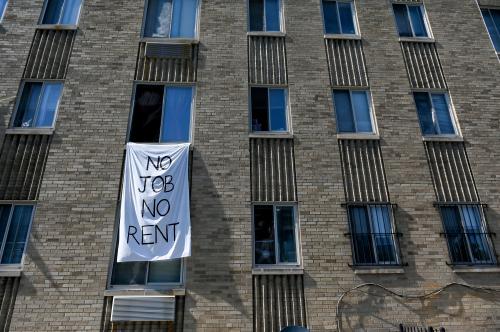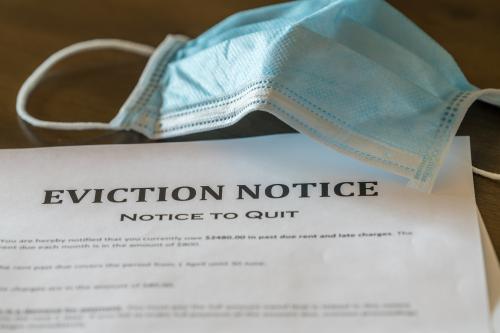Within the first year of the COVID-19 pandemic, 1.5 million rental households were spared a formal eviction, thanks to a collection of eviction moratoria from federal to local levels. However, moratoria did not prevent all evictions from proceeding. Many families were forced from their homes during the pandemic despite public health risks. As Build Back Better legislation evolves, funds for housing have been reduced to $150 billion from more than double that amount, and while it still prioritizes funding for housing vouchers, the legislation does not preserve the bill’s original support levels. To make the most of Build Back Better and other state-level funding, policymakers need to know which households have been most vulnerable to eviction over the course of the COVID-19 pandemic so that additional assistance can be directed toward them.
Surprisingly, our research shows that low-income households already getting federal support may be more vulnerable to eviction than their counterparts who receive no social benefits. Public policies such as federal cash assistance (Temporary Aid for Needy Families/TANF) and the Supplemental Nutrition Assistance Program (SNAP/food stamps), are meant to help families who are experiencing financial hardship; having additional income from these programs could help households reallocate some of their finances toward rent payments, thus avoiding eviction. However, in our examination of housing stability during COVID-19, we found that more households getting SNAP and TANF fell behind on rent, and those getting SNAP had a higher chance of being evicted.
Our data
Using the Socioeconomic Impacts of the COVID-19 Survey administered by the Social Policy Institute at Washington University in St. Louis, we looked at which households had higher risks of being evicted over the first 15 months of the pandemic. The survey was distributed in five waves between April 2020 and June 2021. We restricted our sample to rent-paying households with incomes below 200 percent of the federal poverty line—the most generous income cap for households SNAP qualification—leaving 2,632 rental households in our model. When asking about eviction, we did not distinguish between informal and formal evictions, therefore including renters who both did and did not receive a court-mandated eviction.
What increased the chance of eviction?
Rental households in our sample had a 4.8 percent chance of being evicted.
We found that falling behind on rent is closely connected with eviction, so we first looked at which households were more frequently behind on rent. A significantly larger proportion of the households getting SNAP fell behind on rent (12.6%) compared to 9.6 percent of households not getting SNAP (p<0.05, Figure 1). Similarly, 33.9 percent of households getting TANF fell behind on rent compared with only 9.8 percent of households not getting TANF (p<0.001).

Household job loss, falling behind on rent, and getting SNAP were all significantly associated with eviction (Figure 2). Households that fell behind on rent were 10.1 percent more likely to be evicted than households that were current on their rent (a 14.9% chance overall). Even households that made partial rent payments were more likely to be evicted. In fact, the majority of evicted households were only behind on a month or less (58.2%) of rent. Formal eviction through a court hearing requires more time, suggesting that the majority of the evicted renters in our sample were forced from their homes informally. Household job loss was also a significant factor with a 2.2 percent greater chance of being evicted (7 percent chance overall).
In looking at the role of public benefits, we expected that households receiving SNAP and TANF would be less likely to be evicted due to the income assistance these benefits provide, but we saw a different trend: Receipt of SNAP was associated with a significantly higher chance of eviction for renters while TANF was not. Households getting SNAP were 2 percent more likely to be evicted than households without SNAP and almost as likely as households with job loss to be evicted at over 6.8 percent.

What Next
We find that getting SNAP or TANF does not shelter renters against housing instability: A greater proportion of households with incomes below 200 percent of the federal poverty line and that fell behind on rent were getting SNAP and TANF than those who did not. When we look at the demographics of our sample, as well as consider adverse circumstances, such as job loss and falling behind on rent, households getting SNAP were significantly more prone to eviction.
In the current version of the Build Back Better Act, $150 billion would go toward housing with significant funding allocated for both public housing and housing choice vouchers. In deciding how this funding will be distributed, states should consider the vulnerability of renters who are receiving SNAP to eviction. Further assistance could be directed to these renters in the form of direct cash payments, legal resources, or increased SNAP distributions. New research finds that access to free legal counsel can reduce the number of filings that result in an eviction, indicating a role for legal aid in preventing formal evictions. Efforts could also be made to expand access to legal services for renters prior to any filing, with specific outreach efforts targeted toward those getting SNAP.
Even missing one payment can increase the chance of eviction; therefore, rental assistance needs to reach households before they fall behind on rent. One easy approach is to send direct cash payments to households getting SNAP benefits. Sending payments directly to these households would eliminate burdensome (for both renters and program administrators) application processes while still making sure aid gets to those who need it most.
At a local level, states that opt into using non-recurrent, short-term benefits (NRST) funding could easily distribute assistance to households already getting SNAP. NRST funds are restricted by income, however, so states can ensure these households meet income requirements by distributing the funds directly to SNAP recipients. As research from the Urban Institute has detailed, states have already used TANF funds for rental assistance. By broadly distributing these funds to SNAP recipients, states can target those households most at risk of eviction.
Methods end note: To examine which rental households were at the highest risk for eviction, we used a multilevel, longitudinal model accounting for household demographics and length of time since the onset of the COVID-19 pandemic. We also included state-level fixed effects in the model to account for differences in the eviction and public benefit policy landscapes by location. In addition, we included time-variant markings of financial instability such as household job loss and falling behind on rent.
The Brookings Institution is committed to quality, independence, and impact.
We are supported by a diverse array of funders. In line with our values and policies, each Brookings publication represents the sole views of its author(s).









Commentary
The destabilizing cost of a pandemic: What COVID-19 meant for renters already getting assistance
November 23, 2021